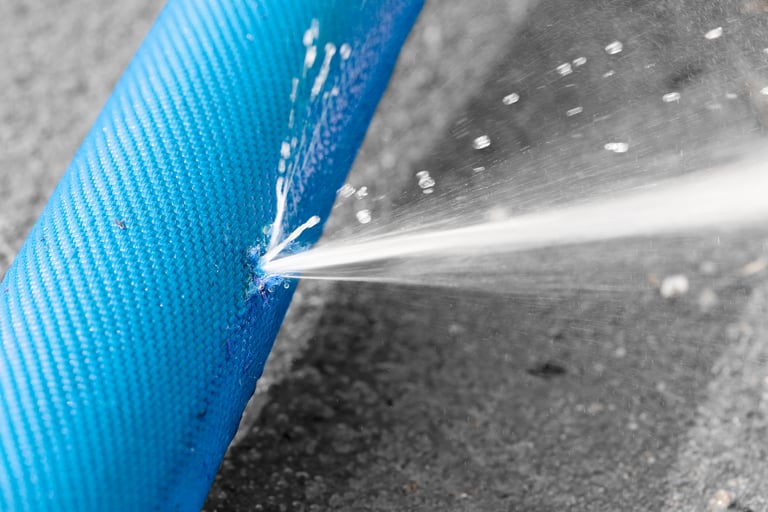 Aging pipe networks, difficult temperature conditions, vibration caused by construction work – there are many causes for leaks in water infrastructure. Unfortunately, leaks often appear beneath the surface where nobody can see them until it’s too late. Billions of drops, millions of cubic meters of drinking water are lost by many water utilities due to leaks every year. How can you minimize these losses? Not just to prevent the lost revenue, but also to conserve the vital resource, to keep drinking water clean, and to prevent buildings and infrastructure from dangerous undercutting. There’s a smart way for water utilities to ensure constant leakage detection with minimal effort. And we’re going to explore it.
Aging pipe networks, difficult temperature conditions, vibration caused by construction work – there are many causes for leaks in water infrastructure. Unfortunately, leaks often appear beneath the surface where nobody can see them until it’s too late. Billions of drops, millions of cubic meters of drinking water are lost by many water utilities due to leaks every year. How can you minimize these losses? Not just to prevent the lost revenue, but also to conserve the vital resource, to keep drinking water clean, and to prevent buildings and infrastructure from dangerous undercutting. There’s a smart way for water utilities to ensure constant leakage detection with minimal effort. And we’re going to explore it.
Water is life – and a fundamental human right
Without water, there’s no food, no nutrition, no health. But for more than two billion people, clean drinking water is out of their reach. With the exception of desert regions, there are thousands of rivers and lakes around the world. But that doesn’t help if they’re massively polluted, like approximately one-third of all rivers in Latin America, Africa, and Asia? That’s why the sixth sustainable development goal (SGD) of the UN General Assembly Resolution Agenda 2030 is “clean water and sanitation.” And one target of the SDG 6 is to “increase water-use efficiency and ensure freshwater supplies.” It calls for measures that cut water withdrawals and ensure that water is used more efficiently: for example, in agriculture, industry, and municipal water supply. One measure to achieve this is to minimize water losses by detecting and fixing leaks in municipal distribution networks. This has a great potential to save water.
While consumers worry about their water use for showering, toilet flushing, or dripping taps, a lot of the municipal water supply doesn’t even reach them: The numbers vary from country to country and city to city, but in the United States alone, every year water utilities lose an estimated average of 17% of their water delivery due to leaks. According to a study from the OECD, the leakage rates of more than 40 cities worldwide ranged from 4% in Amsterdam, Netherlands to 65% in Tuxtla Gutiérrez, Mexico.
That’s a lot of water that neither serves a purpose nor generates revenue. But besides wasting a valuable resource, there are also serious health risks: A study from the University of Sheffield demonstrated that leaks offer potential access for contaminants to enter the pipe network and affect the drinking water. As long as the pressure in the water system doesn’t drop, the leaking water prevents anything from getting into the damaged pipe. But if the dynamic pressure drops due to the leak, that’s when contaminants and bacteria can be sucked in through the hole. Another problem with undetected water leaks is the risk of undercutting buildings, streets, and other infrastructure, endangering the safety and well-being of local residents and/or road users.
Why do leaks occur?
In practice, many pipes are in operation for 50 years or more, and they’re made of materials that were standard like iron, steel, or pre-stressed concrete. But even new materials like stainless steel, PE, and PVC age and develop material fatigue as time flies by. That makes them more vulnerable to cracks or bursting for various reasons, including foundation settling and vibration and loads caused from construction work and mobile machines. At the same time, the pipes are increasingly stressed: Urbanization means that cities are continuously growing and developing new residential areas, and this requires pipe networks to be extended. As a result, the pressure in the network increases and with it the load that’s put on the pipes. You can imagine the outcome in conjunction with the aging and other potential factors.
How can leaks be detected and located?
Widespread water transmission and distribution networks comprise countless branches and many places where cracks can occur. And when they do, it’s primarily unnoticed, hidden underground. There are rarely unwanted fountains in front yards or inconvenient ponds on streets or pavements to indicate that something’s wrong. But even if water utilities recognize that they’re delivering more water than consumers receive, the question remains: Why is there a difference, and where is the missing water going? Is there a leaking pipe, is there more than one leak in the network, aren’t the meters working properly – or is it water theft?
The search for leaks is often conducted once or twice per year, and it involves lots of footwork and labor throughout the district. Technicians use listening equipment on stop valves or on the ground to spot leaks, because water leaking from a pressurized pipe generates acoustic noise. If metal pipes are involved, the noise is more audible than with the PE or PVC pipes that are increasingly being used. To avoid false readings caused by ambient noise, the search is usually done at night. In public areas, that means a lot of work and time. And on private property, access is limited. And if it’s just done once or twice per year, that leaves a lot of time for leaks to occur unnoticed. Of course, there are also permanently installed monitoring systems on the market that can detect leaks sooner. But depending on the pipe material and local conditions, they can also run into problems, including finding the required frequency filters or speed of sound, which makes extensive calculations and/or expensive equipment necessary.
A smarter way to listen to the flow
What if continuous pipe monitoring was much easier? What if the existing pipe infrastructure could be left almost untouched while installing numerous leak sensors? No leaks would go unnoticed because the sound of leaking water wouldn’t need to travel far before being detected by one of the closely placed sensors.
A simple but smart solution is to equip water meters with acoustic leakage detectors. Water meters are needed by every household and have to be replaced with new ones every 10 to 15 years. They’re integrated into the pipes and are therefore perfectly integrated in the network – and that’s ideal for listening for acoustic leakage in the pipe network. Replacing old water meters with new ones with integrated leak detection ensures that nearly every piece of the pipe network is covered. Combining a leak detector unit with a smart water meter makes it even better: The wireless data transmissions from the smart meter can also be used to transmit leak-related data to the water utility. Of course, the power consumption of the leakage detector needs to be very low, because the battery has to last until the meter is replaced.
It’s smart. It’s simple. Smart meters with integrated leakage detection for the distribution network is the next step toward stopping leaking revenue and safety.







